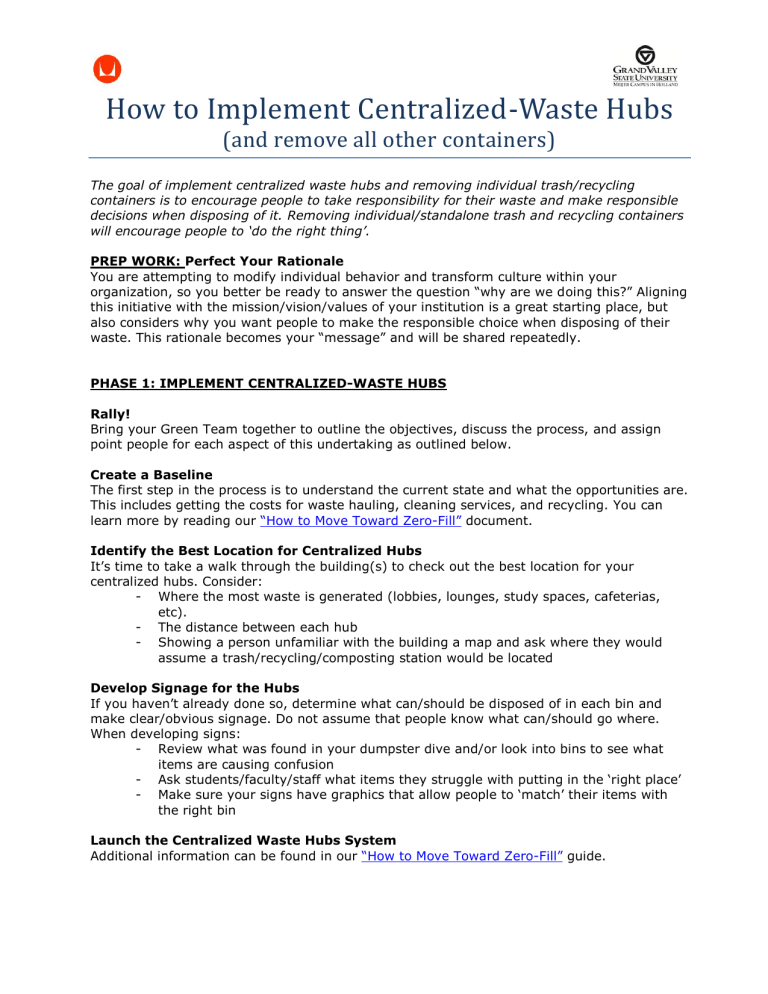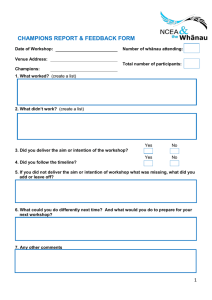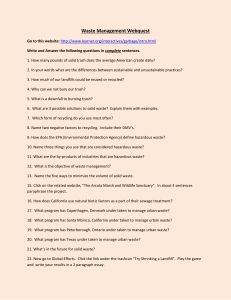
How to Implement Centralized-Waste Hubs (and remove all other containers) The goal of implement centralized waste hubs and removing individual trash/recycling containers is to encourage people to take responsibility for their waste and make responsible decisions when disposing of it. Removing individual/standalone trash and recycling containers will encourage people to ‘do the right thing’. PREP WORK: Perfect Your Rationale You are attempting to modify individual behavior and transform culture within your organization, so you better be ready to answer the question “why are we doing this?” Aligning this initiative with the mission/vision/values of your institution is a great starting place, but also considers why you want people to make the responsible choice when disposing of their waste. This rationale becomes your “message” and will be shared repeatedly. PHASE 1: IMPLEMENT CENTRALIZED-WASTE HUBS Rally! Bring your Green Team together to outline the objectives, discuss the process, and assign point people for each aspect of this undertaking as outlined below. Create a Baseline The first step in the process is to understand the current state and what the opportunities are. This includes getting the costs for waste hauling, cleaning services, and recycling. You can learn more by reading our “How to Move Toward Zero-Fill” document. Identify the Best Location for Centralized Hubs It‟s time to take a walk through the building(s) to check out the best location for your centralized hubs. Consider: - Where the most waste is generated (lobbies, lounges, study spaces, cafeterias, etc). - The distance between each hub - Showing a person unfamiliar with the building a map and ask where they would assume a trash/recycling/composting station would be located Develop Signage for the Hubs If you haven‟t already done so, determine what can/should be disposed of in each bin and make clear/obvious signage. Do not assume that people know what can/should go where. When developing signs: - Review what was found in your dumpster dive and/or look into bins to see what items are causing confusion - Ask students/faculty/staff what items they struggle with putting in the „right place‟ - Make sure your signs have graphics that allow people to „match‟ their items with the right bin Launch the Centralized Waste Hubs System Additional information can be found in our “How to Move Toward Zero-Fill” guide. PHASE 2: REMOVING INDIVIDUAL/STAND- ALONE RECEPTACLES Identify Champions Depending on the size of your organization, you may need to solicit extra buy-in or support to launch a centralized hubs only program. - Consider enlisting champions/representatives from each of the departments or offices on campus/in your organizations. - Consider representatives from groups within your organization that reach many people or have significant pull: Student/Faculty Senate, Student organization officers, etc - Consider „high profile‟ champions such as Presidents, Board Members, etc (note: this isn‟t necessary for success, but is a nice touch!) Pick a Date to Remove Individual/Stand-alone Receptacles Select a date to remove all individual/standalone trash and recycling containers from your building/office/campus. Some things to consider: - Consider putting the recycling bins into place 4 weeks prior to removing trash receptacles. This will help people to become familiar with the process and what goes where. - Coordinating the launch with a mile stone or tradition (start of semester, Earth Day, etc) - Determine how long it will take to develop appropriate materials and train staff prior to the launch Develop Support Materials Ask the Green Team and Champions to consider what sorts of materials might be necessary to develop in order to successfully launch the program with minimal confusion for all constituents. - Consider your audiences and their familiarity with your processes and procedures o Primary: Students, faculty, staff, other employees o Secondary: Community members, guests, visitors, etc - Identify Types of materials needed for each audience. Materials could including: o Training Manual o FAQ list o Notice for guests/conference services o Signage Announce that “Trash Cans are Going Away” This is when knowing your rationale comes in handy. You‟ll need to rely on various forms of communication in order to launch this effectively: - Signage/Branding o Succinctly share “the message” on signs that can be placed on or near individual trash receptacles indicating when and why the container will disappear o Place signage with the message in high traffic areas around campus - Word of Mouth o Equip all champions with “the message” and encourage them to keep it positive o Encourage all champions to tell “the message” to as many people as possible (formally and informally) - Mass Communication o Update your website with information about the initiative o o - P.R. o o Send an email to as many constituents as possible (and be sure to include “the message”) Utilize as many forms of social media as possible to generate conversation. Be sure to have champions and people with “the message” checking these accounts and staying active in the conversation Consider a press release for local media Share the information with your student newspaper and organizations Announce that “Trash Cans Have Gone Away ” This is when the implementation becomes reality. - Signage/Branding o Replace the previous signs with signs that indicate where the new recycling hubs are located. o Place additional signage with the message in high traffic areas around campus - Word of Mouth o Equip all champions with “the message” and encourage them to keep it positive o Encourage all champions to tell “the message” to as many people as possible (formally and informally) - Mass Communication o Update your website with information about the initiative o Send an email to as many constituents as possible (and be sure to include “the message”) o Utilize as many forms of social media as possible to generate conversation. Be sure to have champions and people with “the message” checking these accounts and staying active in the conversation and be ready to answer questions. - P.R. o Consider a press release for local media o Share the information with your student newspaper and organizations Evaluation The best way to evaluate how well the process is working is to do another dumpster dive. This will show what‟s not being recycled. You‟ll be surprised to see how many people make responsible decisions when you make it easy and obvious for them. Integrate the progress into your message. Keep the Program Going! You‟re making major changes on your campus/in your organization and these processes probably won‟t be familiar to “new people” (freshman, new hires, guests, etc). Be sure to share the message when you come into contact with “the new people”. This could be at new student/staff orientations, on campus/facility tours, announcements at the start of major events, etc.



